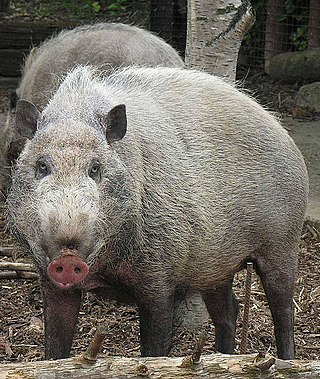
Sus is the genus of wild and domestic pigs, within the even-toed ungulate family Suidae. Sus include domestic pigs and their ancestor, the common Eurasian wild boar, along with other species. Sus species, like all suids, are native to the Eurasian and African continents, ranging from Europe to the Pacific islands. Suids other than the pig are the babirusa of Indonesia, the pygmy hog of South Asia, the warthogs of Africa, and other pig genera from Africa. The suids are a sister clade to peccaries.

The wild boar, also known as the wild swine, common wild pig, Eurasian wild pig, or simply wild pig, is a suid native to much of Eurasia and North Africa, and has been introduced to the Americas and Oceania. The species is now one of the widest-ranging mammals in the world, as well as the most widespread suiform. It has been assessed as least concern on the IUCN Red List due to its wide range, high numbers, and adaptability to a diversity of habitats. It has become an invasive species in part of its introduced range. Wild boars probably originated in Southeast Asia during the Early Pleistocene and outcompeted other suid species as they spread throughout the Old World.

Game or quarry is any wild animal hunted for animal products, for recreation ("sporting"), or for trophies. The species of animals hunted as game varies in different parts of the world and by different local jurisdictions, though most are terrestrial mammals and birds. Fish caught non-commercially are also referred to as game fish.

A feral pig is a domestic pig which has gone feral, meaning it lives in the wild. The term feral pig has also been applied to wild boars, which can interbreed with domestic pigs. They are found mostly in the Americas and Australia. Razorback and wild hog are Americanisms applied to feral pigs or boar–pig hybrids.

The Dogo Argentino is an Argentine breed of large dog of mastiff type. It was bred in the early twentieth century in Córdoba in central Argentina, primarily for hunting large game such as peccaries, wild boar and pumas. The foundation stock included the now extinct Córdoba fighting dog, a fighting dog of bulldog type, a Bull Terrier and a Mastín del Pirineo.
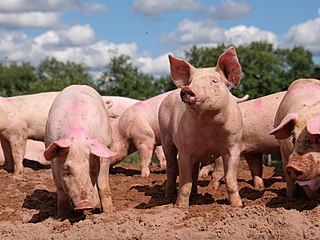
The pig, often called swine, hog, or domesticpig when distinguishing from other members of the genus Sus, is an omnivorous, domesticated, even-toed, hoofed mammal. It is variously considered a subspecies of Sus scrofa or a distinct species. The pig's head-plus-body length ranges from 0.9 to 1.8 m, and adult pigs typically weigh between 50 and 350 kg, with well-fed individuals even exceeding this range. The size and weight of hogs largely depends on their breed. Compared to other artiodactyls, a pig's head is relatively long and pointed. Most even-toed ungulates are herbivorous, but pigs are omnivores, like their wild relative. Pigs grunt and make snorting sounds.

A blood sport or bloodsport is a category of sport or entertainment that involves bloodshed. Common examples of the former include combat sports such as cockfighting and dog fighting, and some forms of hunting and fishing. Activities characterized as blood sports, but involving only human participants, include the ancient Roman gladiatorial games.
Aujeszky's disease, usually called pseudorabies in the United States, is a viral disease in swine that is endemic in most parts of the world. It is caused by Suid herpesvirus 1 (SuHV-1). Aujeszky's disease is considered to be the most economically important viral disease of swine in areas where classical swine fever has been eradicated. Other mammals, such as cattle, sheep, goats, cats, dogs, and raccoons, are also susceptible. The disease is usually fatal in these animal species.

Animals in sport are a specific form of working animals. Many animals, at least in more commercial sports, are highly trained. Two of the most common animals in sport are horses and dogs.

The kangaroo dog or kangaroo hound is an Australian type of sighthound purposely crossbred from a variety of sighthound breeds to produce a hunting dog.
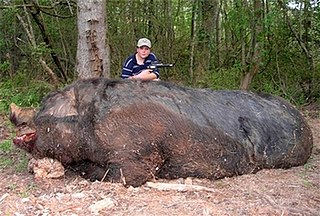
Monster Pig was the subject of a controversial 2007 story that initially ran in the news media as a report of an 11-year-old boy shooting a massive feral pig. The pig was claimed to have been shot during a hunt on May 3, 2007, by an 11-year-old boy named Jamison Stone. The location of the shooting was the Lost Creek Plantation, a commercial hunting preserve outside Anniston, Alabama, US. According to the hunters, the pig weighed 1,051 pounds (477 kg) and measured 9 feet 4 inches (2.84 m) in length.
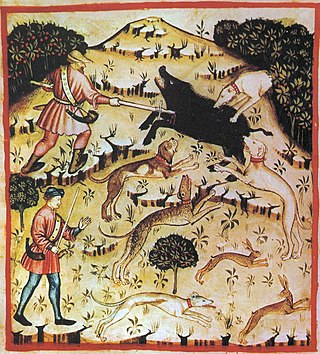
Boar hunting is the practice of hunting wild boar, feral pigs, warthogs, and peccaries. Boar hunting was historically a dangerous exercise due to the tusked animal's ambush tactics as well as its thick hide and dense bones rendering them difficult to kill with premodern weapons.
Uncle Earl's Hog Dog Trials is an annual Hog Dog Baying Event held in the third weekend of March in Winnfield, Winn Parish, Louisiana at the Winn Parish Fair Grounds involving boars and various breeds of bay dogs, including Catahoula Leopard Dogs, Blackmouth Cur, Blue Lacy, and others.

Boar–pig hybrid is a hybridized offspring of a cross between the Eurasian wild boar and any domestic pig. Feral hybrids exist throughout Eurasia, the Americas, Australia, and in other places where European settlers imported wild boars to use as game animals. In many areas, a variable mixture of these hybrids and feral pigs of all-domesticated original stock have become invasive species. Their status as pest animals has reached crisis proportions in Australia, parts of Brazil, and parts of the United States, and the animals are often freely hunted in hopes of eradicating them or at least reducing them to a controllable population.

The Bull Arab is a type of dog developed in Australia by Mike Hodgens and Heather Rea for pig hunting. The dog was developed from crossing large, strong dogs of which the most common were Bull Terriers, Pointing breeds, and Greyhounds. The result was a medium to large size, short-haired, muscular dog.

A catch dog is a specially trained dog that is used to catch large animals in hunting, working livestock, and baiting.

A bay dog is a dog that is specially trained to find, chase, and then bay, or howl, at a safe distance from large animals during a hunt, such as during a wild boar hunt.
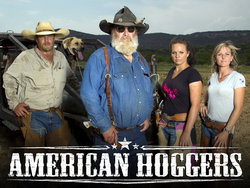
American Hoggers is an American reality television series on A&E that debuted October 19, 2011. The series chronicles the lives of the Campbell family whose family business is professional game hunting and animal control specifically the removal of feral hogs in the state of Texas. Season 4 premiered on October 22, 2013.
Australia has a population of about 25 million, with the Commonwealth Government's 2019 survey estimating there are 640,000 recreational hunters in the country. There are around 5.8 million legally owned guns in Australia, ranging from airguns to single-shot, bolt-action, pump-action, lever-action or semi-automatic firearms.
Boar-baiting is a blood sport involving the baiting of wild boars against dogs.















